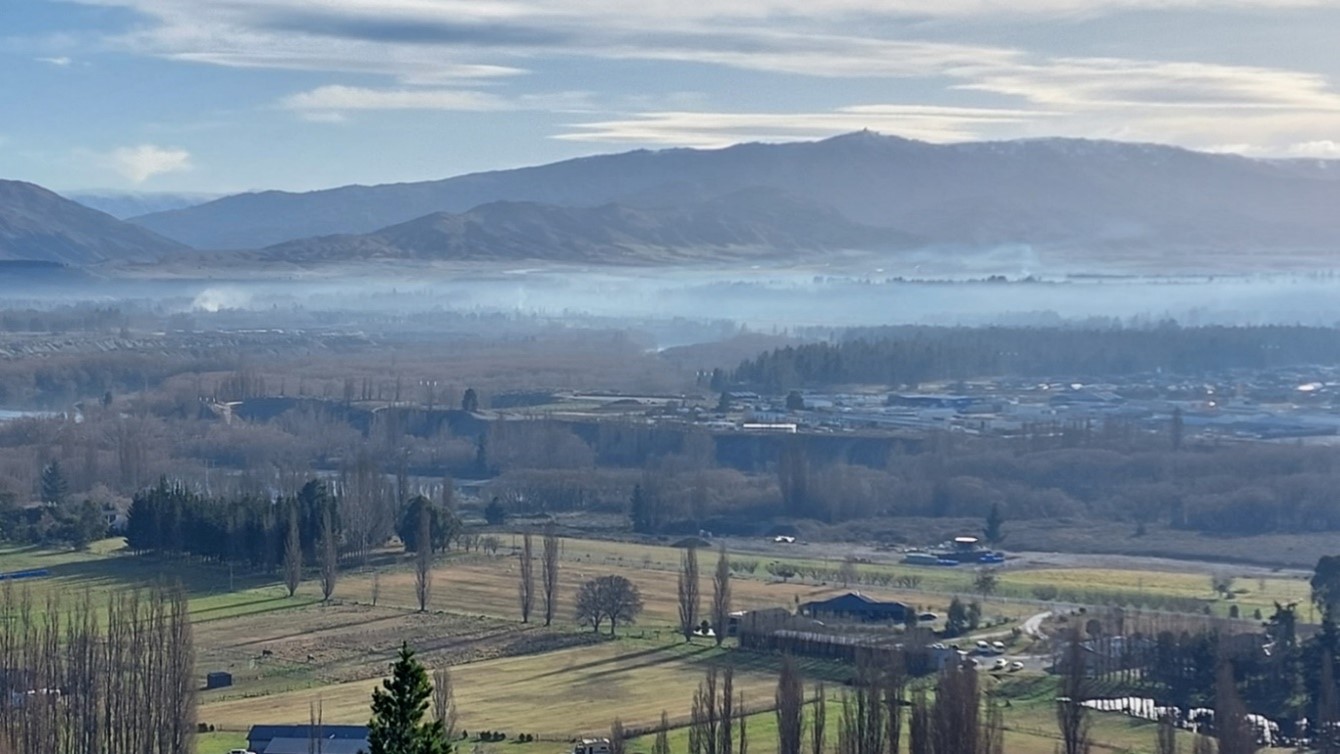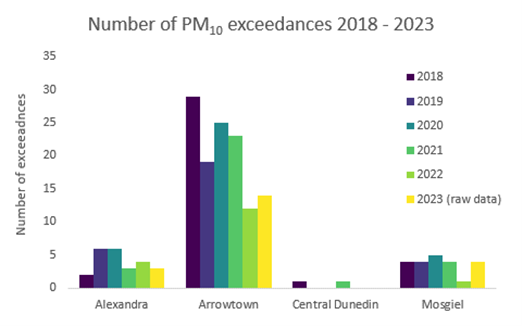ORC’s Scientist – Air Quality, Sarah Harrison says “These winter exceedances are due to a combination of emissions and the environment they are emitted into.”
“These emissions are mostly from wood burners for home heating. We know this because of the extreme seasonal patterns we see in the data.”

An inversion layer of smog over Alexandra
These breaches of ambient air quality were all publicly reported in the ODT, as required under the National Environmental Standards for Air Quality (NESAQ, 2004).
The NESAQ requires ORC to measure particulate matter emitted into the air with a diameter of 10 micrometres or less (PM10). That is about the width of a human hair.
PM10 includes solid or liquid particles from vehicle, industry, and home heating emissions such as wood fires, as well as from natural sources.
To understand our air quality in relation to the NESAQ, ORC undertake a continuous air quality monitoring programme. This winter we found there were 21 breaches of national air quality standards - three in Alexandra, 14 in Arrowtown and four in Mosgiel.
“So far this year, June has been the worst month for exceedances due to region-wide cold snaps,” Ms Harrison says.
The NESAQ for 24-hour PM10 is 50 micrograms per cubic metre of air (µg/m3). Below is a graph that shows the number of times in the last in the last six years when PM10 has gone beyond this limit.


NB: 2023 data is still in the process of being confirmed.
The biggest improvement is in the number of air quality exceedances in Arrowtown over the past six years, although there is still plenty of room for improvement.
Ms Harrison says, “Year on year, PM concentrations vary. Many of the towns in Otago have the geography and climate that allows pollution to build up, rather than disperse. Low temperatures and windspeeds sometimes cause inversion layers to form, which traps pollution at ground level.
ORC continually monitors these areas, and often conducts further research in other parts of Otago that helps determine where PM hotspots are and how these concentrations could be reduced.
Ms Harrison says “An increase in air quality studies, monitoring sites, and upgrades of instruments are all part of a move to better monitor the finer PM2.5 and focus on combustion-related sources of particulate matter.
More information on the work being done around Otago can be read here.
Ms Harrison notes her team are concerned about this. “We have some of the worst ambient air particulate matter (PM) concentrations in the country. PM, like other air pollutants, is very dangerous to our health and responsible — globally and nationally — for large numbers of premature deaths, respiratory and cardiovascular disease, and restricted activity days.
“It is for reasons like these that ORC’s Burn Dry, Breathe Easy campaign in winter is so important,” she says.
ORC staff are also currently reviewing the Air Plan and will be consulting on changes to the plan in 2024 and 2025. Staff are considering whether more rigorous rules are needed to improve air quality in the region’s urban areas and will be discussing options with our communities next year.
There are a number of things we can all be doing things to help reduce these levels of particulate matter including replacing older wood burners, open fires, and multi-fuel burners with ultra-low emission burners, or better yet, looking into alternative heating such as pellet burners or heat pumps.
For those with a wood burner, it is important to follow best practise burning techniques to reduce emissions and this starts with burning dry wood, and only putting wood and paper in your wood burner. If done right, the first 10-15 minutes is likely to produce smoke but there should be no visible smoke thereafter.
For further tips, ORC’S Burn Dry, Breathe Easy web page can provide some further guidance.
